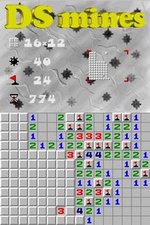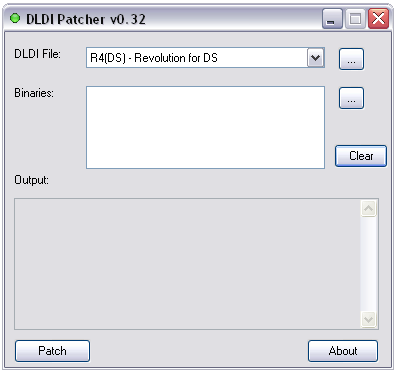-
Dldi Patcher V0 32카테고리 없음 2020. 3. 4. 02:23

The AMD / ATI Pixel Clock Patcher modifies the AMD / ATI driver to provide high resolutions and refresh rates by removing the 165 MHz pixel clock frequency for 1 channel DVI and HDMI, the 330 MHz limit for 2 channel DVI and 400 MHz for VGA. Instructions:. Open atikmdag-patcher.exe.
The program will find all the limits, select 'Yes' to fix and re-sign the driver. If something went wrong, reinstall the driver for the video card, or look for a new version of Atikmdag patcher- RebootThen you can choose higher update rates using the program for detailed settings of video cards.To restore an unsigned driver, re-open the patcher and select “Yes” to restore from backup.Updates:1.4.7: New SL-DVI / HDMI limit found. 1.4.6: Found a new HDMI-DVI limit.
1.4.5: Updated for 17.4.1. Found new limit DP-DVI / HDMI. 1.4.4: BIOS signature verification found. 1.4.3: Fixed HBlank limit for 16.12.1. 1.4.2: 56 horizontal blanking limits (HBlank) found. 1.4.1: Corrected an error that prevented the driver from loading correctly in earlier versions of Windows 10. 1.4.0: Updated for 16.9.1.
Changed the way the driver is located and repaired. Replaced 640 × 480 constraint with low resolution constraint. Fixed limit VGA for 32-bit. 1.3.6: Limit found in 10 permissions for Radeon settings. 1.3.5: Updated for 15.11 Crimson.
Found 640 × 480 limit for Radeon settings. We tried to improve the limit on DVI / HDMI for new drivers. Removed blue screen bypass for 14,6 / 14,7. 1.3.3: Updated for 15.3. Fixed limit DVI / HDMI for 32-bit. 1.3.2: Updated for 15.2.

Fixed limit DVI / HDMI for 64-bit. 1.3.1: Find the HDMI 1.3 + limit in 297 MHz.
Perform 3 times to properly upgrade an existing installation. 1.3: The blue screen workaround for 14.9 has been removed. Return to self-signing if the signature failed. Attempt to circumvent some anti-virus false positives. No reprint needed.
1.2.6: Fixed AMD APP encoding for 14.6. 1.2.5: Updated for 14.6. Fixed TMDS and VGA limitations.
Implemented workaround for blue screen SYSTEMSERVICEEXCEPTION. 1.2.4: Updated for 14.4. Fixed SL limit on DL-DVI. 1.2.3: Updated for 13.30 and later releases of 14.x.
1.2.2: Found a new HDMI limit for 12,9 +. 1.2.1: VGA 400 MHz limit found. 1.2: Test mode is no longer required.

Contents.What is DLDI? (how did it come about?)DLDI stands for ‘Dynamically Linked Device Interface’. It is an interface for libfat that homebrew developers attached to their projects.I’ll break it down to more understandable terms. Let’s say a homebrew developer makes a DS game where you can draw a picture and save the image to your flash cart.
To save this image on the flash cart the developer would have to know the specific piece of code that allows you to write things to the cart. And if you wanted to read the image so you can edit it again you’d need access to the read capabilities of the flash cart. This forms the read/write commands which are essentially what libfat is.There is a big problem however. Every flash cart uses different read/write commands. That would mean to get your game working on four different flashcarts you’d need to code it with all four different read/write methods. This is a big hassle for developers and flash cart owners a like.
Under the old system homebrew projects that used read/write commands (FAT access) only worked on the flashcarts they were specifically coded for. As there are so many flash carts on the market many were left out because to keep your homebrew project working on 15 + different kits would be a nightmare!Along came DLDI. This interface developed by Chishm unifies everything. It is a single interface that homebrew developers attach to their projects.
The developers don’t have to worry about making their project compatible with a whole range of different carts. Instead each flashcart has a specific DLDI patch made for it which houses all the read/write commands. You would then simply patch the homebrew game or application with your cart’s DLDI patch and it will work on your cart. So if you have an R4 DS you apply the R4 DS DLDI patch to the homebrew.nds file.
The beauty is that once a DLDI patch has been made for your cart it’ll be compatible with every piece of homebrew that has DLDI support.What carts are supported?DLDI support is defined as, at a minimum, the ability to patch a.nds file for a specific cartridge. Virtually all cartridges support DLDI either officially or via third-party intervention. Most cart developers have advanced beyond manual DLDI patching in various ways, such as automatic DLDI patching. Some carts that are compatible with the interface include the following:AceKard+DSLinkDS-XtremeEwin2EZ-Flash IVEZ-Flash VG6-Flash (Lite)M3 Adapter (CF)M3 Adapter (SD)Max Media DockGBA Movie Player (CF)GBA Movie Player (SD)NEO flash MK2 & MK3NEO2Ninja DSNinjaPass X9R4 DSM3 DS SimplySupercard (CF)Supercard (SD)Supercard LiteSupercard DS OneYou can download DLDI patches from the.What Homebrew games/apps do I need to patch?Any homebrew game or application that uses FAT access and supports DLDI.
Homebrew games/apps that do not read or write to your card do not need to be patched.How do I patch my homebrew games/apps?DLDI is either automatically patched by the cartridge software or manual patching is necessary.Manual DLDI Patching, an Example:. Download a DLDI patcher from the such as a. Download the appropriate DLDI patch file matching the name of the flash cart. Select the DLDI file. Select.nds homebrew files in the ‘binaries’ section.
Dldi Patcher V0 32 8
Click ‘Patch’Note: EZ-Flash V users will need to use a separate DLDI patcher to make DLDI work. If you have an EZ-Flash V please use this DLDI patcher. No other files are needed, simply drag and drop the homebrew onto the exe file.External Links.